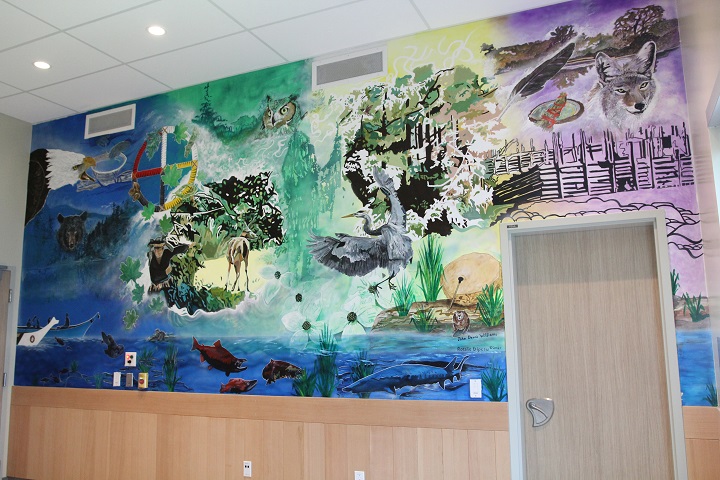
Rosalie Dipcsu-Williams, a member of the Squamish Nation and a visionary artist and healer, creates murals and other works of art for healing spaces around B.C. Her work caught the eye of the Kwikwetlem First Nation, who commissioned a mural for the Red Fish Healing Centre for Mental Health and Addiction.
Together with her spouse John, Rosalie has spent 188 hours creating the mural that adorns a wall of the centre’s Hummingbird Room, where spiritual and cultural healing activities, including smudging, will take place.
“Being able to do this work has been truly special for me; it’s an impeccable moment for my heart,” says Rosalie. “As First Nations people, we see a lot of people struggling with mental health and drug use issues in the community. This room and mural are meant to take the weight off people when they come in here, to help them feel free.”
When Rosalie first met with the Kwikwetlem First Nation, their desire to have their culture understood, recognized and represented was clear.
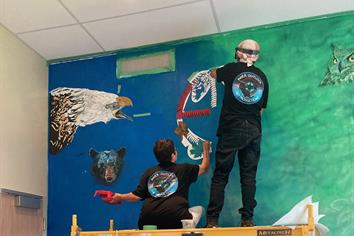 “For us, this mural represents our people coming home,” says Chief Ed Hall of the kʷikʷəƛ̓əm First Nation. “Our Nation has always had close and enduring ties to the lands of səmiq̓wəʔelə/Riverview which have been source of great healing, safety, and spiritual practice for our people for thousands of years. With this work, we wanted the healing power of our lands, waters, wildlife and plants to help those who visit the Red Fish Healing Centre along their journey to recovery and a healthy life. Having an artist so beautifully capture nature’s healing power is extremely important to our Nation in our role as stewards and guardians of the lands, waters and all that is above and below.”
“For us, this mural represents our people coming home,” says Chief Ed Hall of the kʷikʷəƛ̓əm First Nation. “Our Nation has always had close and enduring ties to the lands of səmiq̓wəʔelə/Riverview which have been source of great healing, safety, and spiritual practice for our people for thousands of years. With this work, we wanted the healing power of our lands, waters, wildlife and plants to help those who visit the Red Fish Healing Centre along their journey to recovery and a healthy life. Having an artist so beautifully capture nature’s healing power is extremely important to our Nation in our role as stewards and guardians of the lands, waters and all that is above and below.”
Rosalie’s vision came to life through a combination of over 20 techniques perfected over three decades, including impressionism, realism, and graphic and abstract art.
“We started off by creating stencils for every part of the mural,” says Rosalie. “We drew up designs to the exact measurements of the room, and used a projector to map them onto the wall. Then we put down our basic images—there are 21 of these—that represent the rich culture of the peoples and lands, as well as power, healing, wisdom and so much more. I then added realistic detail to each of the animals, birds and fish. Finally, I put this all into a dreamscape, using my visioning skills to push and pull sections of the painting to come to life. The end result is a piece that draws people in—everyone will get something different from this.”
Every component of the piece has its own meaning and purpose, and has been intentionally placed within the scene.
“In the centre, we have the healer,” says Rosalie. “I was inspired by a photograph of a healer that came to Kwikwetlem in the 1960s to remove a hex on the territory. He’s standing on dogwood flowers, which are native to B.C. and still exist here today. They bring his healing powers from the past into the present. I have also embellished this wheel with his sacred healing plants—cedar, tobacco, sage and sweet grass—as well as representing all cultures through colour. The white people have knowledge, the black people have movement, the yellow have wisdom, the red people have vision. The message here is that if we use our given gifts together, we will foresee unity.”
The mural features wild B.C. animals and water life, which Rosalie explains play an important role in recovery and healing.
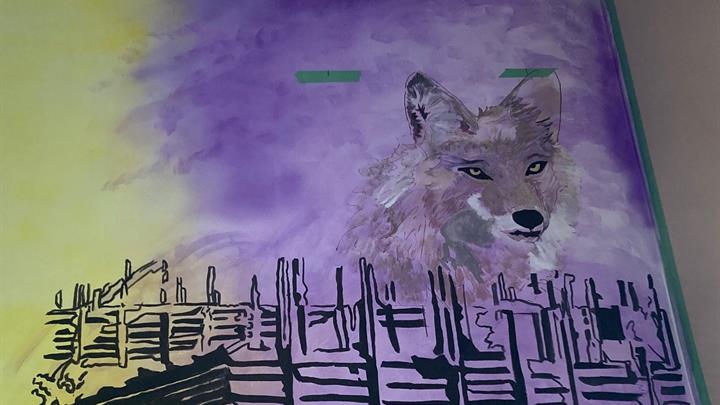
“Up on the right, we see our coyote, the tracker,” Rosalie says. “They cover huge distances, always moving, very much like the recovery journey. In the centre, we have the great blue heron, which represents the freedoms of the people. We have him in flight, taking off to the beating of a drum. I wanted to make that dominant. The owl, a wise guardian, is very subtle, just observing the healing and journeys of those in this space, while the eagle is the visionary figure, crying out a call for the people. The black bear is the power and strength.”
The mural also depicts salmon, which the Kwikwetlem people have relied on for nourishment for centuries, as well as sturgeon and eulachons. It also features Indigenous peoples, past and present, on the water.
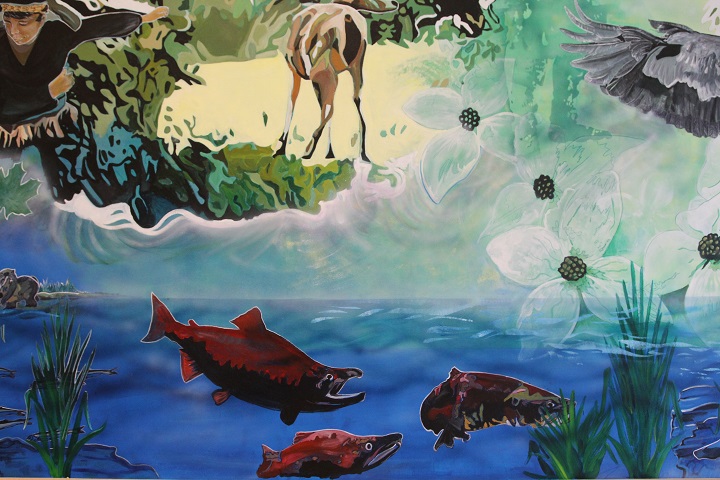
“We have the earlier canoes here with paddlers in their ancestral regalia; they are in passage,” says Rosalie. “We also have a modern-day canoe with the Nation’s insignia alongside the earlier one.”
Rosalie and John have great hope that the Red Fish Healing Centre for Mental Health and Addiction will help people in need.
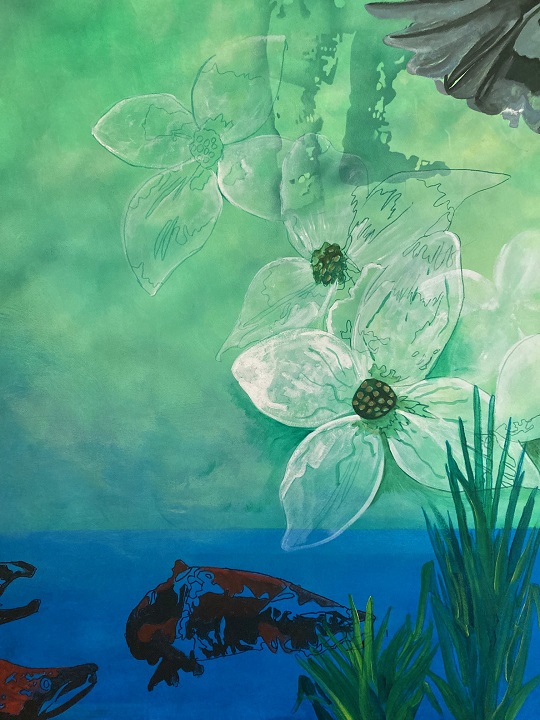
“We do Indian medicine work in the community, brushing people in their homes,” Rosalie says. “A lot of young adults in their early 30s are battling addiction or mental health issues. To have somewhere like Red Fish that is so large, so beautiful—somewhere to pull people in where they can feel warmth—that’s what is needed. We want to capture and hold the hearts of people struggling. While they sit in this room and go through whatever they are experiencing, it will calm them down. I want them to take these images in, maybe even lose themselves in the images and feel they are a part of this special scene.”
This mural is one of several Indigenous pieces that adorn the walls of the Red Fish Healing Centre, all of which contribute to the welcoming, warm atmosphere in the facility.
“Everything about this centre was designed with clients in mind,” says Connie Coniglio, the chief operating officer for Complex Mental Health and Substance Use. “We have bright open spaces, warm colours, lots of natural light and green spaces, as well as beautiful works of art by various local Indigenous artists. We want people staying with us at Red Fish to feel supported in their recovery and Rosalie’s mural in the Hummingbird Room is a key part of making that happen.”
